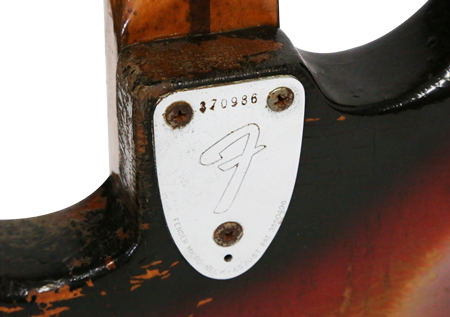

The profile became a thinner C for 1960 and the C filled out later in 1961.Įarly veneer necks feel quite chunky compared to 1960s and 1961 examples. The V-shape softened towards the end of 1957 and in 1958 changed to a slimmer D-profile, which was retained through 1959 after the rosewood ’board was introduced. The V-necks are often quite full, but slimmer examples can be found. In 1956, Fender refined the profile to a soft V, which became a harder V in 1957.
JAPANESE FENDER STRATOCASTER SERIAL NUMBERS GUIDE FULL
Between 19, Strat necks were quite full and rounded. Neck profiles vary, but there are some general guidelines. Heavily worn original frets being removed sideways on a 1963 Strat with clay dots. Japanese nuts are metric, so they are incompatible with imperial threads. If in doubt, remove the truss-rod adjustment nut and see if an American nut will fit. Some vintage-style necks manufactured in Japan can look very similar to 1950s and 60s American necks.

Also look for a mark on the underside of the heel, like it has been punched with a crosshead screwdriver. If you’re assessing a vintage neck, look for pin holes under the D tuner and on the heel.

Router templates were used to cut the neck outline and they were secured using pins. Look for sharpened tangs on the treble side – they should appear thinner than the bass side tangs if they’re original. If you see chips around the frets, they’re probably replacements. Maple ’boards remained available by special order after 1958, but they were glued on like rosewood slab ’boards.įender installed frets sideways and they should really come out the same way. 19 necks may have clay or celluloid dots, but celluloid quickly became standard. They may appear grey, slightly beige, brown or off-white depending on condition and playwear. Pre-CBS rosewood ’boards had ‘clay’ dots but there’s no consensus on the actual material Fender used. Fender stopped dating necks for a brief period in 1959. Neck dates at the body end were pencilled on up to 1962 and stamped from 1962. The earliest veneers were the thickest and Fender retained veneer ’boards throughout the remainder of the vintage era. Image: Eleanor Janeįender introduced veneer or round-lam fretboards in July 1962, with thin rosewood glued over radiused maple. A strip of walnut was used to fill the channel. The ‘one-piece’ maple necks of 1954-59 have truss rods installed via a channel routed in the back. The slab should just skim the top of the trussrod nut hole and if there’s any maple between the hole and the join line, the neck probably isn’t genuine. The maple’s upper surface was left flat and the fretboard was radiused after being glued on top. In 1958, Stratocaster necks acquired slab rosewood fretboards and front-loaded truss rods with no walnut strip or plug. A strip of walnut was used to fill the channel, with a walnut plug on the front of the headstock. But whether you are in the market for a player-grade example, an all-original collector’s piece or simply searching for vintage parts for restoration purposes, this guide will help you identify the key features. Serial numbers cannot be relied on without corroborating evidence, and it’s important to check if all the features correspond with the supposed manufacturing date.įrom a player’s perspective, so long as you are clear about what you’re buying and the guitar is priced accordingly, there’s nothing wrong with ‘assembled’ or refinished vintage Strats. Ideally a vintage Strat will come with provenance, and perhaps photographs taken over the decades, but it’s rarely the case. READ MORE: The best S-style guitars to buy.Authenticating them is fairly complex and even if you can verify the constituent parts, there’s no guarantee that they all left the Fender factory on the same day. The demand for vintage Stratocasters has never been higher, and neither have the prices.


 0 kommentar(er)
0 kommentar(er)
